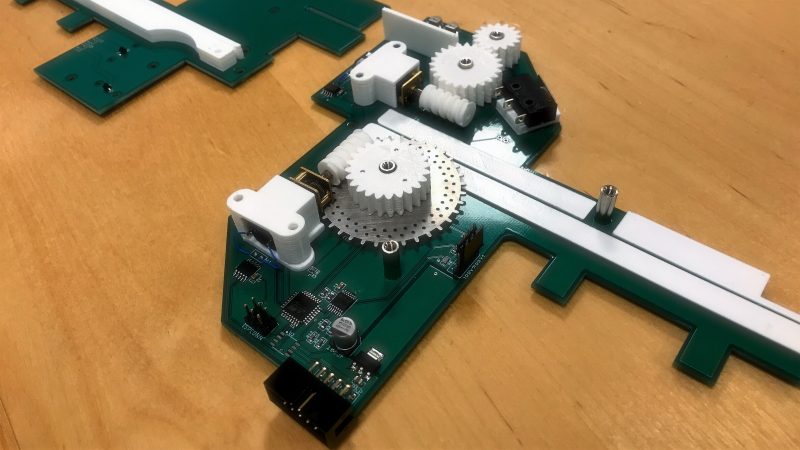When your widgets have proven so successful that building them gets to be a grind, it might be time to consider a little mechanical help in the form of a pick and place machine (PnP). If you’re going to roll your own though, there’s a lot to think about, not the least of which is how to feed your beast with parts.
Managing the appetite of a PnP is the idea behind this custom modular parts feeder, but the interesting part of [Hans Jørgen Grimstad]’s work-in-progress project has more to do with the design process. The feeders are to support a custom PnP being built in parallel, and so the needs of one dictate the specs of the other. Chief among the specs are the usual big three: cheap, fast, and reliable. But size is an issue too insofar that the PnP could be working with dozens of component reels at once. Flexibility was another design criteria, so that reels of varied width can be accommodated.
With all that in mind, [Hans] and company came up with a pretty slick design. The frame of the feeder is made out of the PCBs that house the motors for handling the tape, and the ATmega168 that controls everything. Tapes are driven by a laser-cut sprocket driven by 3D-printed worm gears. The boards have fingers that mate up to the aluminum extrusion that the PnP will be built from, and at only a few millimeters wider than the tape, lots of feeders can be nestled together. The video below shows the feeder undergoing some tests.
Alas, this build isn’t quite done, so you’ll have to check back for the final schematics and PCB files if you want to build one for yourself. While you’re waiting, you might want to build your own pick and place.
Thanks for the tip, [Thomas Langaas].















Yep, that fine toothed drive wheel is tricky to build, but we did get a few laser-etched out of stainless steel.
We used inkscape’s gear path generator, and then manually removed every second tooth.
Full disclosure, at about $1000 into our PnP project… our club had a moment of clarity and simply bought a TVM802B instead. I’m cheering for you guys, as I know how finicky these builds are. =)
If anyone is interested, I could post our version of the gear cutting svg path file with the quadrature-encoded spoke-wheel and m3 tap-size hole.
That would be great (posting the gear cutting path).
For simplicity, you could just post it to the OpenPnP thread on this feeder from yesterday where someone asked for the same thing: https://groups.google.com/forum/#!topic/openpnp/ljO_S5QGK6M
I’m currently working on a PnP machine myself and hoping not to break the bank: https://hackaday.io/project/45404
I pushed what I have left over from our project (includes ponoko template), and some tips here:
https://github.com/Joel-Mckay/Pick-And-Place_OSH_feeder
Best of luck =)
How fast were you aiming to feed those components?
We were testing modified 10kg/cm direct-drive servos with bearing supported brass gears (ours used M3 axle threads), and laser-cut acrylic feeder paths. The indexing time is limited by the number of tractor-feed holes needed per cycle, protective-tape tear-off tensioner, and keeping it as slow as possible to prevent exposed parts jumping off the tape. This gear is as small as we could make it without binding, and was very fast indeed due to the spoke-wheel gear diameter (we never maxed out the 4kg pull limit). You will notice the holes in thicker tape will slightly deform after being fed though, as this was also designed for thin plastic-carrier tapes (i.e. it has a mild pressure angle unlike the traditional feeder gear designs, and likes a spring-loaded downward centering force).
I think if we ever tried the project again, we’d probably try those 28BYJ-48 based gear-head $1.50 steppers. As the speeds are not as load dependent as continuous-rotation hobby-servos, and holding position does not rely on friction alone. Also, I should probably mention our design used 3 staggered overlapping drive assemblies to avoid the dense cartridge form-factor issues (i.e. no need for complex worm or crown gear drive assemblies).
I can send out a few unprocessed gears from 2016 (needs filing down etching tabs) in North America by snail-mail, as it would be awesome if people with more time can recycle our old work. Send me a message on github if you want to try one in your design (I can donate the stamps), as these were certainly an annoying part to prototype in quantity.
Interesting but pneumatic feeders and blocks are pretty cheap on robotdigg. People complain about neoden4’s electronic feeders. But if it can work and be cheaper than pneumatic then great.